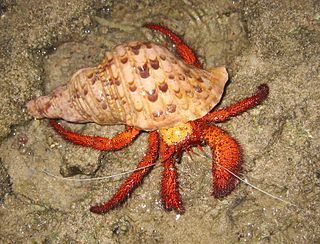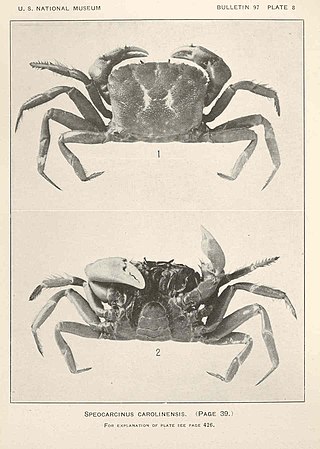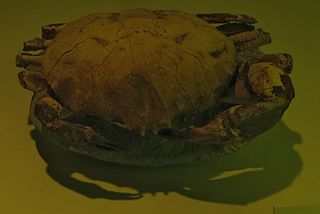
Anomura is a group of decapod crustaceans, including hermit crabs and others. Although the names of many anomurans include the word crab, all true crabs are in the sister group to the Anomura, the Brachyura.

The Parastacidae are the family of freshwater crayfish found in the Southern Hemisphere. The family is a classic Gondwana-distributed taxon, with extant members in South America, Madagascar, Australia, New Zealand, and New Guinea, and extinct taxa also in Antarctica.

The pie crust crab, is a species of crab found around New Zealand and south-eastern Australia.

Cancridae is a family of crabs. It comprises six extant genera, and ten exclusively fossil genera, in two subfamilies:
Metacarcinus starri is an extinct species of crab in the family Cancridae, subfamily Cancrinae. The species is known solely from the early Miocene, Clallam Formation and the underlying Pysht Formation deposits on the Olympic Peninsula of Washington state, United States.

Hexapodidae is a family of crabs, the only family in the superfamily Hexapodoidea. It has traditionally been treated as a subfamily of the family Goneplacidae, and was originally described as a subfamily of Pinnotheridae. Its members can be distinguished from all other true crabs by the reduction of the thorax, such that only seven sternites are exposed, and only four pairs of pereiopods are present. Not counting the enlarged pair of claws, this leaves only six walking legs, from which the type genus Hexapus, and therefore the whole family, takes its name. Some anomuran "crabs", such as porcelain crabs and king crabs also have only four visible pairs of legs. With the exception of Stevea williamsi, from Mexico, all the extant members are found either in the Indo-Pacific oceans, or around the coast of Africa.
Acantholambrus is an extinct genus of crab. It contains the single species Acantholambrus baumi, and was named by Blow and Manning in 1996.
Actinotocarcinus is an extinct genus of Miocene crab, and is the only genus in the subfamily Actinotocarcininae of the family Epialtidae, though was originally classified in the family Majidae. Actinotocarcinus comprises two species, A. chidgeyi, and A. maclauchlani, both from Miocene-aged marine strata of New Zealand.
Componocancer roberti is an unusual species of fossil crab described in 2008. It lived in the Albian age in what is now Montana. The species is unlike any other described crab, and is therefore placed in its own family and superfamily.
Glaessneropsoidea is a superfamily of fossil crabs. They are found in rocks from Late Jurassic age to Late Cretaceous. The 45 species in the superfamily are divided among 11 genera in four families:

Hepatus is a genus of crabs in the family Aethridae, containing seven extant species, plus some fossil species:

Cyclida is an extinct order of crab-like fossil arthropods that lived from the Carboniferous to the Jurassic and possibly Cretaceous. Their classification is uncertain, but they are generally interpreted as crustaceans, likely belonging to the superclass Multicrustacea.

Speocarcinus is a genus of crabs in the family Pseudorhombilidae, containing six extant species, one fossil species from the Late Miocene, one fossil species from the Eocene (Lutetian) and one fossil species from the Early Eocene (Ypresian):
Jurellana tithonia, the only species in the genus Jurellana, is a fossil crab. It was found in limestone rocks from the Ernstbrunn Formation in Austria, which have been dated to the Tithonian. It was originally thought to be the world's oldest porcelain crab, but was later determined to actually be a true crab.

Oregonia is a genus of crabs, comprising two extant species and one fossil species: It is classified in the family Oregoniidae under the spider crab superfamily Majoidea.
This list of fossil arthropods described in 2012 is a list of new taxa of trilobites, fossil insects, crustaceans, arachnids and other fossil arthropods of every kind that have been described during the year 2012. The list only includes taxa at the level of genus or species.

Coeloma is an extinct genus of crabs belonging to the family Mathildellidae. The genus includes 19 species, distributed among several subgenera, and is in need of revision. The fossil record of the genus extends from the Eocene to the Miocene.
Notopus is a genus of frog crabs from the family Raninidae, it consists of a single extant species and two extinct species.
Paralomis debodeorum is an extinct species of king crab which lived in New Zealand during the Middle–Late Miocene. It was discovered in the Greta Siltstone on Motunau Beach, North Canterbury, near the mouth of the Motunau River. It is a moderate-sized Paralomis and most closely resembles the extant Paralomis zealandica.

Tumidocarcinus is an extinct genus of crabs in the family Tumidocarcinidae, containing the following species:











